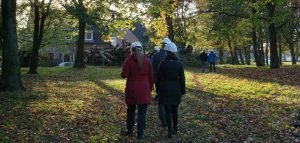What is being circular?
Being circular is a new economic model that, committed to protect the environment, and aware of the constraints of the planet
- Questions and reassesses human needs
- Uses the minimum natural resources to satisfy people’s needs
- Selects resources intelligently and responsibly, by minimizing those non-renewable, and favouring the use of recycled materials or biomaterials
- Manages the resources used efficiently, by maintaining and recirculating them into the system as many times as possible, reducing waste production. Ideally, including materials, in “infinite loops” of reuse
- Minimizes environmental impact and advocates for nature restitution by promoting its regeneration
- Seeks to improve people’s health and well-being, and care for other living beings, giving value to human activities
We live on an “island”, planet Earth is floating on outer space and has limited resources, which are rapidly dying out to supply human way of life. The only riches coming from outside the planet is solar energy. This allows the growth of plants and, therefore is an essential element to provide with food and other biomaterials, such as wood or hemp. Other mineral-based resources on our planet consequently are not renewable, not at least on the human time scale. It is necessary to take appropriate action, to do something about it and do so now. A solution is to opt for circularity in all areas of daily life and therefore, to go for a more sustainable home.
What is a linear economy?

The linear economy is the way we dominantly run our lives and meet our needs. The materials and fossil fuels that we extract from nature, used for many purposes, are discarded once they have served their purpose. Too often, these materials are sorted as waste, residues, or garbage too soon, and their inherent value is seldom recognised beyond their original use. Every piece of equipment that we use (including buildings or technology, for example) are made from a series of non-renewable elements.
What problems does linear economy entail?

The linear economy is the way we dominantly run our lives and meet our needs. The materials and fossil fuels that we extract from nature, used for many purposes, are discarded once they have served their purpose. Too often, these materials are sorted as waste, residues, or garbage too soon, and their inherent value is seldom recognised beyond their original use. Every piece of equipment that we use (including buildings or technology, for example) are made from a series of non-renewable elements.
What is a circular economy and why is it the solution to environmental issues?

The circular economy is a model that strives to recover as many materials as possible over and over again, by using human ingenuity; its goal is to minimize the number of materials and elements considered as waste, through different ways of reducing, reusing, and recycling them, and using renewable energy in all these processes, for example, using wastepaper for building insulation. By implementing new similar practices, we have the chance of reducing the use of non-renewable sources and begin to favour the possibility of long-term survival on the planet, lessening our ecological footprint.
Why do we focus on households and building sector?

Buildings, in general, are responsible for a large part of environmental impact, they account for approximately half of the CO2 emissions we produce and the material we use. At the same time, buildings are an essential part of our lives, for example, roofs offer us protection against cold and heat, provide with safety, allow us to develop leisure activities and offer pleasant workplaces. Buildings and indoor spaces have a great impact on our health and well-being. Therefore, they are one of the key pieces of the puzzle, and they must be approached from a circular viewpoint. Since a very high percentage of the population spends almost 90% of their time inside buildings, these are also aspects in which people can reduce consumption.
Lines of action

Production, consumption, waste management, secondary raw materials and water reuse
Consumption and production are interconnected; if we consume responsibly (decrease consumption), we will need to produce less. We are often unaware of the difference between our real needs, which have to be satisfied to fulfil our life, and the artificial needs created by the society in which we live, surrounded by advertising and marketing campaigns.
For example, critically questioning the value of items produced from wood in our homes (such as cabinets, chairs or dining tables), and the need of changing this habit frequently is one of the aspects to bear in mind to promote a positive impact. What is more, it is necessary to be aware of the final destination of objects and materials once they have reached the end of their life span as it is a key factor. A large majority of the resources in our daily life, including those objects that are part of our households and buildings, can significantly extend their life span by reusing them for less demanding purposes or in other contexts, or finally being recycled to get more basic materials or create new items. We may not always be aware, but water also requires energy for its adequacy and distribution, so that in addition to being an essential element that make life on earth possible, water saving also means a reduction in energy, and positively impacts climate change.
Stages of circularity in households

In our homes, workplaces, etc., in which we live and develop daily life, we can introduce circularity by implementing very simple practices, which will help us to experiment and understand what extending the life span of materials.
We can start by reusing different construction materials or extending the life span of furniture in our homes, for example, chairs and kitchen fronts, by considering their renovation and repair, for instance with a new coat of paint, instead of discarding and replacing them at the slightest sign of wear. If our home needs a renovation, it is possible to implement circular practice to buildings similarly. For instance, by maintaining some elements, such as windows, and asking suppliers to acquire recycled materials or biomaterials, or thoroughly planning building dismantling before renovation and rebuilding, to introduce as many existing elements as possible.
